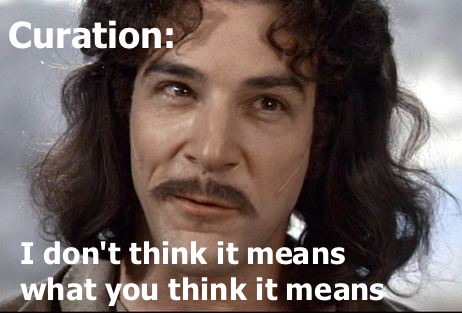“Content curation” is one of those phrases that gets repeated ad naseum without much thought about what it actually means or what role it plays in our digital lives.
It’s a term that is widely used, yet the definition (at least in the social media marketing sense) is murky and unspecific.
Let’s define what digital content curation really is and what it’s not, and how we can begin to think about this term a little differently.
The distribution of content
What I think people mean when they talk about content curation is the sharing of content from different sources on social media. While that’s not entirely wrong, it doesn’t capture the full picture. This basic definition opens the door for some common practices that can be frustrating and unproductive.
Frequent, regular automation
For a lot of people, social media curation involves some automation, which is funny because automation feels like the opposite of curation. It’s simple to set up an automated flow of tweets or LinkedIn posts that go out when a blog post is released, as many do with their company’s blog (or even their personal one).
I am not a proponent of this method for a couple of reasons.
1.) These communications weren’t crafted by a human brain. For example, tweets that have the exact headlines of blog posts, headlines that are too long, posts that have too many characters, and the use of the exact same post across multiple channels are good examples of this type of communication. This is a problem because if it’s obvious that a robot is doing the talking for you, real humans are not going to be inspired to talk back.
2.) It’s unrealistic. Unless your blog is all of your own content, it’s not likely that you would share every single post from a feed. Not to mention, why would someone want to follow your content if they can get the exact same information from their RSS feed? Not only does feed automation look lazy, it could also portray you in a negative light which, doesn’t exactly inspire trust.
This is what I call link spraying. In the attempt to execute on one best practice (consistent sharing) these folks violate a few others: trust, context, and humanness.
Hand selection and scheduling
Hand selecting content to share is infinitely better than automation. For one thing, you have to read at least a portion of the content you are sharing. You’re also helping to shape your identity through what you share. It used to be that your digital self was composed of what you created. This is still true (although those who create content are more highly valued than those who exclusively share it) but, what we associate ourselves and our brands with are co-creators in our online identities.
Note: There is a big difference between automation and scheduling. In most cases, scheduling or hand selecting content to share and scheduling for later publication is just fine. It’s helpful to those who want to provide a steady stream of relevant content while remaining responsive. I myself use Hootsuite for this purpose.
Sharing with context
Let’s not let the definition of curation stop here. “Hand selection” is still not digital curation in and of itself. Without ever adding any unique perspective or context, you aren’t adding to the conversation, you’re simply parroting.
Does that mean you need to comment on every retweet or share? Of course not. There is value in simply sharing. Breaking news is one example that comes to mind. But, is there value in just passing along every article that everyone in the industry has already seen? Probably not.
Twitter is not a curation tool
Twitter is a fantastic discovery and sharing mechanism but, you can’t curate there. Tweets are fleeting, they’re there and then they’re not. There’s a lot of serendipity involved in what you see in your Twitter stream. But, you can certainly use Twitter to lead folks to where you curate.
For example, blogs and websites are the ultimate curation tools because of their flexibility. As are photo albums, Pinterest boards, Storify, YouTube channels, some Facebook apps, and perhaps hundreds of other examples. These are examples of curation tools because they are destinations that house selectively placed, found objects.
Defining the process
Okay, we’re getting warmer. Let’s review. Digital content curation is definitely NOT automation and it’s not mindlessly reposting already popular content. What digital curation does include is hand selecting great content and often commenting or otherwise providing context or a unique perspective to accompany a piece of content.
So…we’re done, right? Having a frequently updated Twitter stream filled with interesting, engaging content from obscure sources that you contextualize is content curation, right?
Not so fast. A curator isn’t just someone who can find great “stuff,” though it is an important skill. A curator is someone who creates a specific experience using found objects and contextualizes those objects within a limited space. A curator not only collects and interprets, but houses that work to create unique experiences.
The Internet is a big place
And those who point us in the right any direction are becoming increasingly valuable. By making the Internet smaller, focusing our attention, providing context, and creating relevant experiences, curators actually enhance our online experiences.
Let’s hold curation up to the standard that it deserves and stop pretending that interesting tweets = content curation. This process takes time, skill, and creativity that should be recognized.
What curation tools do you use? I’m experimenting with a few new kinds and am curious to know what others are doing in this space. Tell me your thoughts below.
